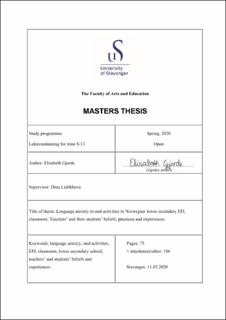| dc.description.abstract | This thesis addressed the issue of language anxiety in oral activities in Norwegian EFL classrooms. In particular, lower secondary EFL teachers’ and their students’ beliefs, practices and experiences were explored through teacher interviews, student focus group interviews and a student questionnaire, all conducted in three Norwegian lower secondary schools.
The study aimed to answer two main research questions, with a focus on Norwegian lower secondary EFL teachers’ and their students’ perspectives on language anxiety. Furthermore, the two research questions were divided into six subquestions: how the teachers’ beliefs formed their understanding of language anxiety, and how they defined it, what experiences with language anxiety the teachers had, and how the teachers approached their students’ language anxiety in order to reduce it in class, as well as what the students’ beliefs about language anxiety were, what the students’ experiences with language anxiety were, and what attitudes the students had concerning their teachers’ approaches to oral activities in EFL lessons to prevent language anxiety.
Mixed methods research was applied in the present study. In particular, the researcher used teacher interviews and student focus group interviews and questionnaires. Three lower secondary EFL teachers were interviewed in order to investigate the teachers’ beliefs, practices and experiences. Furthermore, a student questionnaire was filled out by 49 students. In addition, three student focus group interviews were conducted. All the students participating in the focus group interviews and questionnaires were taught by the interviewed teachers.
The main findings revealed that the teachers believed that language anxiety was connected to the students’ lack of self-confidence, and that it was connected to the personality type introversion. The teachers experienced teaching students with language anxiety in the EFL classroom but had not learned about it in their education. The most anxious students appeared high-achieving students, so the teachers did not believe low language-learning aptitude was a reason for language anxiety in class. The teachers attempted to reduce language anxiety in students by building academic confidence in them and by giving them positive experiences when they had oral activities in the EFL classroom. The predictable structure of the lessons and classroom seating were also approaches used to reduce language anxiety.
The students and teachers agreed that high self-exposing activities, such as oral presentations and reading aloud, were the most anxiety increasing activities in the EFL classroom. The teachers’ and the students’ beliefs coincided on that social media benefited students’ language learning and thus reduced language anxiety. In addition, their experiences agreed in that a variety of low self-exposing activities, such as group work, table games, two-minute talk and speed dating, were useful to reduce language anxiety.
The students believed the main reasons for their classmates’ anxiety were the critical evaluation of others and the fear of making mistakes and being ridiculed. The students also believed there would be negative consequences if their teachers did not deal with anxiety in class. The students deemed it useful when their teachers encouraged and supported them in oral activities and tests. The students found it anxiety reducing that their teachers primarily used English in the EFL classroom. In addition, the students believed their teachers being calm and patient reduced language anxiety in them.
The study contributes to research done on language anxiety in the Norwegian context, which has so far been scarce to the best of the researcher’s knowledge. Moreover, it provides teachers with useful information as regards dealing with and reducing language anxiety in the EFL classroom. The ultimate goal of the study was to create awareness of the problem of language anxiety, especially in oral EFL activities, among future EFL teachers in Norwegian schools in order to help them to aid anxious students in their language learning. | en_US |

